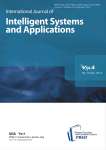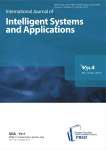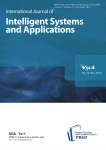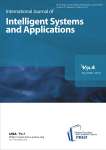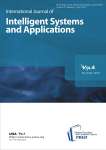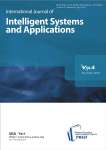International Journal of Intelligent Systems and Applications @ijisa
Статьи журнала - International Journal of Intelligent Systems and Applications
Все статьи: 1214
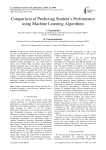
Comparison of Predicting Student’s Performance using Machine Learning Algorithms
Статья научная
Predicting the student performance is playing vital role in educational sector so that the analysis of student’s status helps to improve for better performance. Applying data mining concepts and algorithms in the field of education is Educational Data Mining. In recent days, Machine learning algorithms are very much useful in almost all the fields. Many researchers used machine learning algorithms only. In this paper we proposed the student performance prediction system using Deep Neural Network. We trained the model and tested with Kaggle dataset using different algorithms such as Decision Tree (C5.0), Naïve Bayes, Random Forest, Support Vector Machine, K-Nearest Neighbor and Deep neural network in R Programming and compared the accuracy of all other algorithms. Among six algorithms Deep Neural Network outperformed with 84% as accuracy.
Бесплатно
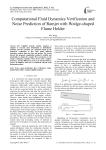
Статья научная
The Lighthill acoustic analogy equation is adopted to research noise distribution at dissimilarity positions and the variations are conducted based on the numerical verification of flow field under different turbulence models, time step sizes and meshes. The results showed the proposed computation method is reliable and practicable to obtain the complex flow parameters in the ramjet combustion chamber; Most of the noise is higherfrequency,and the differences in the near and far field are proven. In addition, noise laws are identical with the same horizontal position
Бесплатно
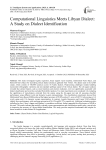
Computational Linguistics Meets Libyan Dialect: A Study on Dialect Identification
Статья научная
This study investigates logistic regression, linear support vector machine, multinomial Naive Bayes, and Bernoulli Naive Bayes for classifying Libyan dialect utterances gathered from Twitter. The dataset used is the QADI corpus, which consists of 540,000 sentences across 18 Arabic dialects. Preprocessing challenges include handling inconsistent orthographic variations and non-standard spellings typical of the Libyan dialect. The chi-square analysis revealed that certain features, such as email mentions and emotion indicators, were not significantly associated with dialect classification and were thus excluded from further analysis. Two main experiments were conducted: (1) evaluating the significance of meta-features extracted from the corpus using the chi-square test and (2) assessing classifier performance using different word and character n-gram representations. The classification experiments showed that Multinomial Naive Bayes (MNB) achieved the highest accuracy of 85.89% and an F1-score of 0.85741 when using a (1,2) word n-gram and (1,5) character n-gram representation. In contrast, Logistic Regression and Linear SVM exhibited slightly lower performance, with maximum accuracies of 84.41% and 84.73%, respectively. Additional evaluation metrics, including log loss, Cohen’s kappa, and Matthew’s correlation coefficient, further supported the effectiveness of MNB in this task. The results indicate that carefully selected n-gram representations and classification models play a crucial role in improving the accuracy of Libyan dialect identification. This study provides empirical benchmarks and insights for future research in Arabic dialect NLP applications.
Бесплатно
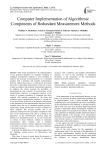
Computer Implementation of Algorithmic Components of Redundant Measurement Methods
Статья научная
This article demonstrates the implementation of the proposed algorithm for computer modeling of redundant measurement methods to solve problems to improve the accuracy of measurements of a controlled quantity with a nonlinear and unstable transformation function. Improving accuracy is achieved by processing the results of redundant measurements which are an array of data according to the proposed measurement equations. In addition, the article presents the possibility of determining the time variation of the parameters of the transformation function. A comparative analysis of the results of computer simulation of redundant and direct methods with unstable parameters of the linear and nonlinear sensor transformation functions is carried out. It was proved that, in the case of an increase in deviations of the parameters of the transformation function from the nominal values, the use of redundant methods provides a significantly higher measurement accuracy compared to direct methods. This became possible due to the automatic elimination of the systematic component of the error of the measurement result due to a change in the parameters of the transformation function under the influence of destabilizing factors. It was also found that, in contrast to direct methods, methods of redundant measurements allow working with a nonlinear transformation function without additional linearization or dividing it into linear sections, which also contributes to increased accuracy. In general, the application of the proposed approach in the modeling system proves its effectiveness and feasibility. Thus, there is reason to argue about the prospects of redundant measurements in the field of improving accuracy with a nonlinear and unstable transformation function, as well as the possibility of identifying deviations of the parameters of the transformation function from their nominal values.
Бесплатно
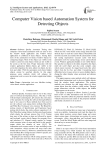
Computer Vision based Automation System for Detecting Objects
Статья научная
Software Quality Assurance Testing time computer vision based automation tools are used to test the window based application and window based application is combined of many objects. Among them most of the automation tool detect window objects by comparing images. Most of the objects are visible in the window screen but some objects which are not visible to the screen at the first time. Proper interaction with the window application hidden objects get visible to the screen like dropdown list item, editor text object, list box item and slider. With the automation tools these hidden objects cannot be searched directly. In this paper proposes some methods which will enhance the automation tools to access the window application hidden objects.
Бесплатно
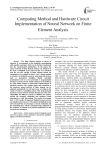
Computing Method and Hardware Circuit Implementation of Neural Network on Finite Element Analysis
Статья научная
The finite element analysis in theory of elasticity is corresponded to the quadratic programming with equality constraint, which can be further transformed into the unconstrained optimization. In the paper, the neural network of finite element solving was obtained on the basis of Hopfield neural network that was reformed. And the no error solving of finite element neural net computation was realized in theory. And a design method to construct an artificial neuron by using electronic devices such as operational amplifier, digital controlled potentiometer and so on was presented. A programmable hardware neural network of finite element can be build up by using analog switches to interconnect inputs/outputs of hardware neurons. The weights, biases and connection in the hardware neural network of finite element can be adjusted automatically by microprocessor according to the results of train to controlling system, This programmable hardware neural network of finite element has some more adaptability for different systems. In addition, the authors present the computer simulation and analogue circuit experiment to verify this method. The results are revealed that: 1) The results of improved Hopfield neural network are reliable and accuracy; 2) The improved Hopfield neural network model has an advantage on circuit realization and the computing time, which is unrelated with complexity of the structure, is constant. It is practical significance for the research and calculation.
Бесплатно

Conceptual analysis of different clustering techniques for static security investigation
Статья научная
Power system contingency studies play a pivotal role in maintaining the security and integrity of modern power system operation. However, the number of possible contingencies is enormous and mostly vague. Therefore, in this paper, two well-known clustering techniques namely K-Means (KM) and Fuzzy C-Means (FCM) are used for contingency screening and ranking. The performance of both algorithms is comparatively investigated using IEEE 118-bus test system. Considering various loading conditions and multiple outages, the IEEE 118-bus contingencies have been generated using fast-decoupled power flow (FDPF). Silhouette analysis and fuzzy partition coefficient techniques have been profitably exploited to offer an insight view of the number of centroids. Moreover, the principal component analysis (PCA) has been used to extract the dominant features and ensure the consistency of passed data with artificial intelligence algorithms’ requirements. Although analysis of comparison results showed excellent compatibility between the two clustering algorithms, the FCM model was found more suitable for power system static security investigation.
Бесплатно
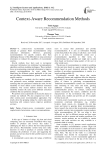
Context-aware recommendation methods
Статья научная
A context-aware recommender system attempts to generate better recommendations using contextual information. However, generating recommendations for specific contexts have been challenging because of the difficulties in using contextual information to enhance the capabilities of recommender systems. Several methods have been used to incorporate contextual information into traditional recommendation algorithms and data modeling techniques. These methods focus on incorporating contextual information to improve general recommendations for users rather than identifying the different context applicable to the user and providing recommendations geared towards those specific contexts. We develop two methods: the first method attaches user preference across multiple contextual conditions, assuming that user preference remains the same, but the suitability of items differs across different contextual conditions. The second method assumes that item suitability remains the same across different contextual conditions but user preference changes. We perform some experiments on the last.fm dataset to evaluate our methods. We also compared our work to other context-aware recommendation approaches. Our results show that grouping ratings by context and jointly factorizing with common factors improves prediction accuracy.
Бесплатно

Статья научная
The main contribution of this paper is the design of a robust model reference fuzzy sliding mode observation technique to control multi-input, multi-output (MIMO) nonlinear uncertain dynamical robot manipulators. A fuzzy sliding mode controller was used in this study to control the robot manipulator in the presence of uncertainty and disturbance. To address the challenges of robustness, chattering phenomenon, and error convergence under uncertain conditions, the proposed sliding mode observer was applied to the fuzzy sliding mode controller. This theory was applied to a six-degrees-of-freedom (DOF) PUMA robot manipulator to verify the power of the proposed method.
Бесплатно
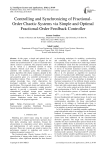
Статья научная
In this paper, a simple and optimal form of fractional-order feedback approach assigned for the control and synchronization of a class of fractional-order chaotic systems is proposed. The proposed control law can be viewed as a distributed network of linear regulators wherein each node is modeled by a PI controller with moderate gains. The multiobjective genetic algorithm with chaotic mutation, adopted in this work, can be visualized as a combination of structural and parametric genes of a controller orchestrated in a hierarchical fashion. Then, it is applied to select an optimal knowledge base, which characterizes the developed controller, and satisfies various design specifications. The proposed design and optimization of the developed controller represents a simple powerful approach to provide a reasonable tradeoff between computational overhead, storage space, numerical accuracy and stability criterion in control and synchronization of a class of fractional-order chaotic systems. Simulation results show the satisfactory performance of the proposed approach.
Бесплатно
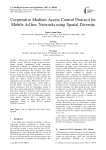
Cooperative Medium Access Control Protocol for Mobile Ad-hoc Networks using Spatial Diversity
Статья научная
Enhancement the Performance of MANET (Mobile Ad-hoc Network) using spatial diversity. Spatial diversity implemented using cooperative transmission technique in Medium access control (MAC) layer level protocol. In noisy environment limit the network performance like coverage area, limit number of node, degrade packet transmission rate, increase packet loss rate etc. In this paper enhance the source to destination transmission range, minimize the packet loss, improve packet transmission rate and appropriate end to end delay. When direct link is fail to transmit packet then Cooperative scheme help to transmit packet. Cooperative scheme is to help the packet transmission with five handshakes instead of four. This scheme implemented in MANET network on MAC layer protocol. Cooperative scheme improve the performance with help of intermediate node between sources to destination. We are performance analysis using discrete simulator NS-2 in MANET. Our performance based on MAC layer level with cooperative scheme in IEEE WLAN standard CSMA/CA protocol.
Бесплатно
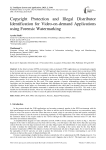
Статья научная
In the direct-to-home (DTH) environment video-on-demand (VOD) applications are tremendously popular due to its inexpensive and convenient nature. In VOD approach legal customers can connect their set-top boxes (STB) to the Internet and can access or record the available content. Due to the easy transmission of the highest quality digital data to the customers by the pay-per-view approach, the data are highly at risk. The data can be vulnerable for illegal distribution of duplicate copies and they are prone to unnecessary modifications which creates a financial loss to the information creators. So it is necessary to authenticate the owner as well as the illegal distributor to reduce the digital piracy which is the motivation for this work. This paper presents a forensic watermarking scheme for protecting copyrights, and for identifying the illegal distributor who distributes the legal copy in the illegal fashion though it is copyright violation. In this paper, two watermarks are embedded in the video that is on-demand, where one watermark is the owner’s information and another watermark is related to the unique information of the STB. This work is also suitable for the biomedical domain, where one watermark can be the patient information and another watermark will be the health center information, in order to secure the patient information and the hospital information.
Бесплатно
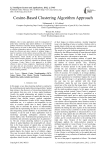
Cosine-Based Clustering Algorithm Approach
Статья научная
Due to many applications need the management of spatial data; clustering large spatial databases is an important problem which tries to find the densely populated regions in the feature space to be used in data mining, knowledge discovery, or efficient information retrieval. A good clustering approach should be efficient and detect clusters of arbitrary shapes. It must be insensitive to the outliers (noise) and the order of input data. In this paper Cosine Cluster is proposed based on cosine transformation, which satisfies all the above requirements. Using multi-resolution property of cosine transforms, arbitrary shape clusters can be effectively identified at different degrees of accuracy. Cosine Cluster is also approved to be highly efficient in terms of time complexity. Experimental results on very large data sets are presented, which show the efficiency and effectiveness of the proposed approach compared to other recent clustering methods.
Бесплатно
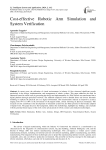
Cost-effective Robotic Arm Simulation and System Verification
Статья научная
In recent years, the utilization of virtual environments in industry 4.0 has witnessed significant growth, particularly in the design, implementation, and management of robotic systems. This paper addresses the need for enhanced control in robotic arms by presenting the design and implementation of a 5DoF robotic arm transformed into a digital platform through specialized software. The methods employed involve detailed direct and inverse kinematic modeling to replicate the physical arm in a digital environment. Our measurements indicate an impressive accuracy ranging from 97% to 100% in the movements of the digital model, closely mirroring its physical counterpart. This research not only contributes to the development of simulation systems but also holds promise for the broader adoption of digital twins. The paper discusses the background, outlines the methodology, highlights key findings, and concludes with the potential future impact of this work on the advancement of robotic systems and simulation technologies.
Бесплатно

